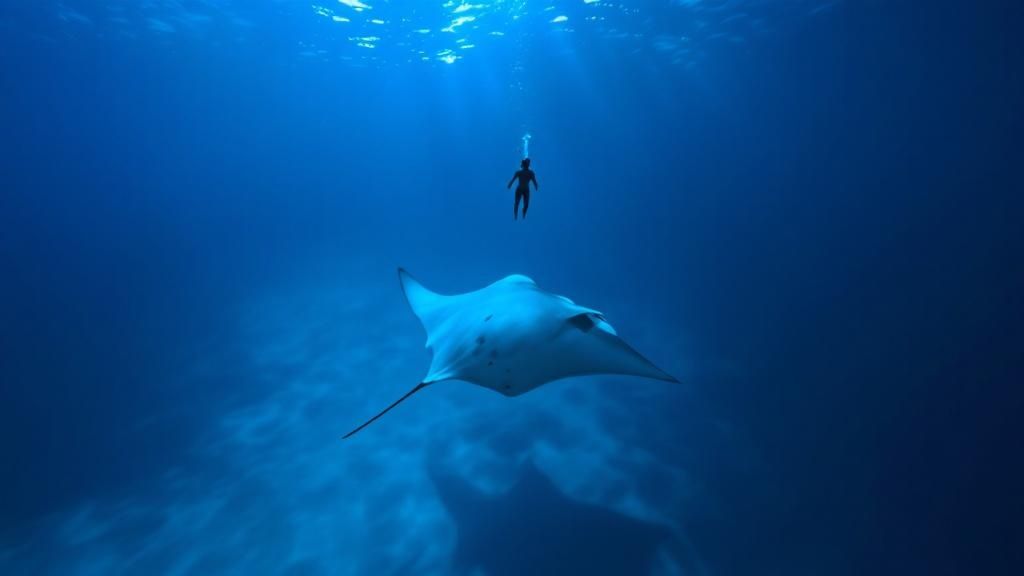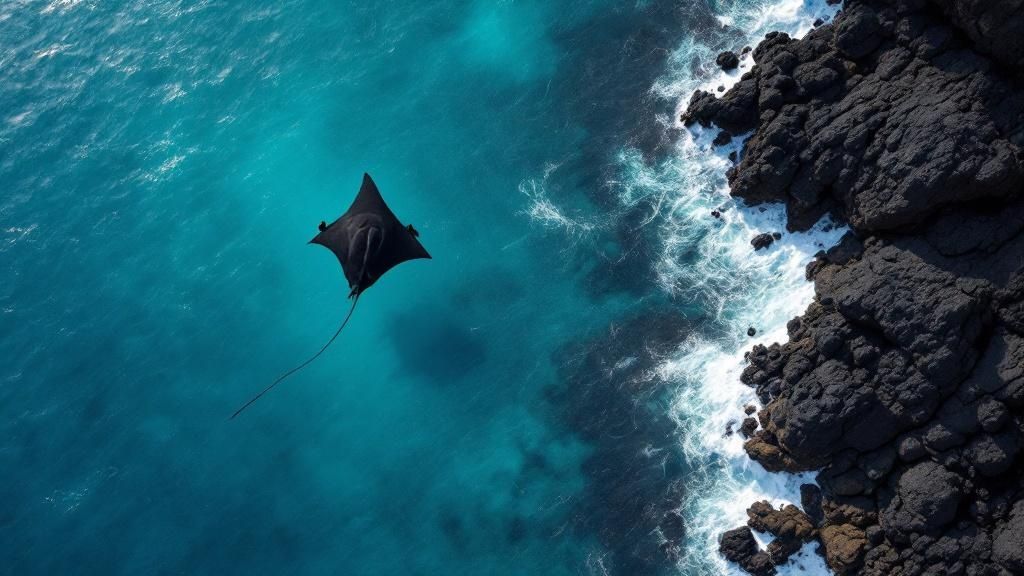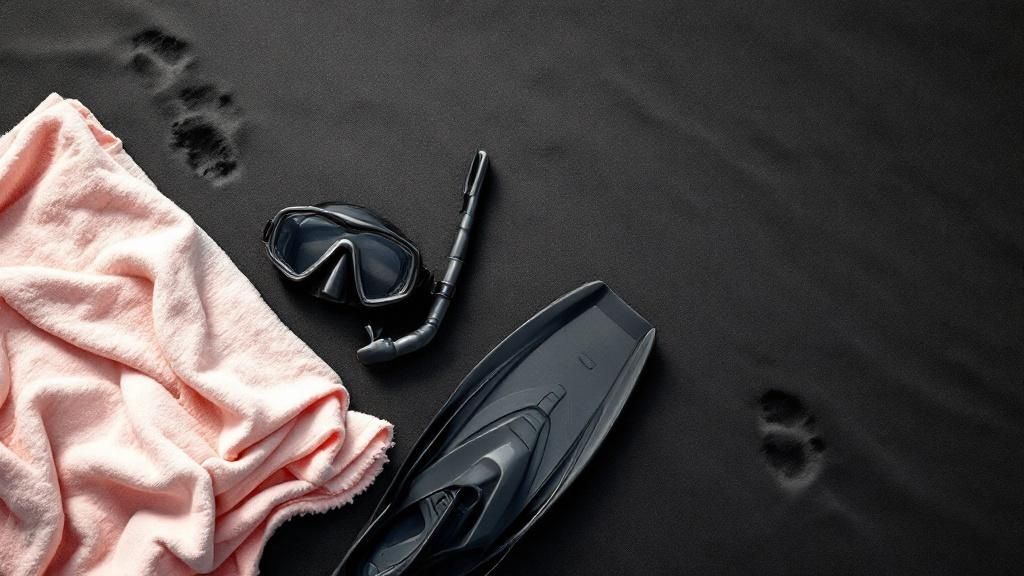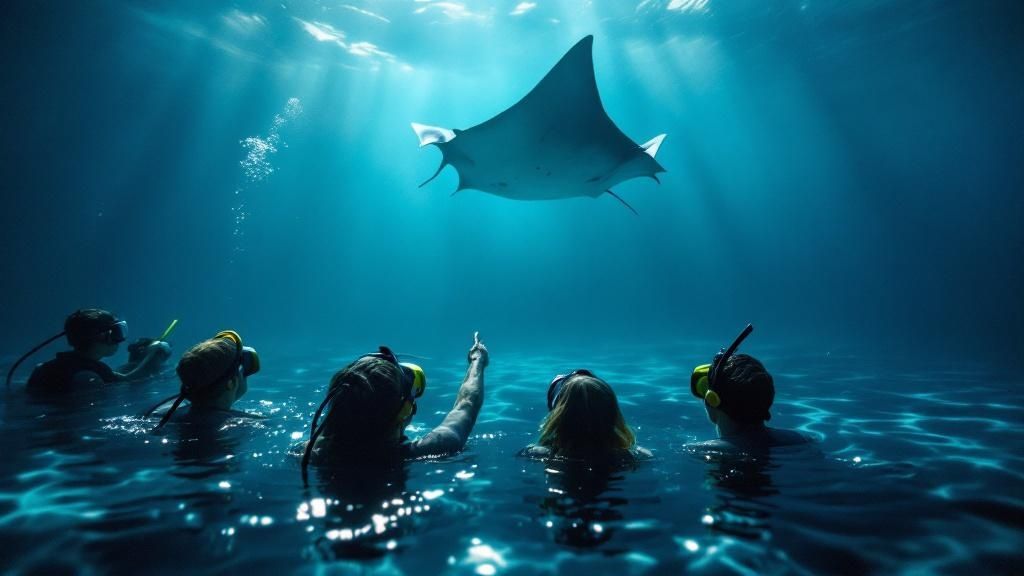Manta Ray Snorkel Big Island | Unforgettable Night Experience
- Byron
- Jul 2
- 15 min read
Swimming with manta rays on the Big Island isn't just another tour; it’s one of the most reliable and awe-inspiring wildlife encounters you can have anywhere in the world. This experience, centered almost exclusively on the Kona coast, has an incredibly high success rate, and for good reason.
Why Kona is the Manta Ray Capital of the World

When people talk about seeing manta rays up close, the conversation always leads to the Kona coast. It's not just a popular spot; it's a global phenomenon. The island's volcanic origins have created a unique underwater environment—a perfect setup for a vibrant marine ecosystem that keeps these gentle giants returning night after night.
This isn't just a lucky coincidence. The Big Island is the place for manta ray encounters because of a few key factors. The area is home to a healthy, resident population of over 450 identified manta rays. Tour operators consistently report an 85-90% success rate for sightings on their nightly trips.
How is this possible? The volcanic coastline creates nutrient-rich upwellings that attract huge amounts of plankton, which is the primary food source for manta rays. You can learn more about these fascinating Kona manta ray statistics on konahonudivers.com. This nightly feast is what you’re really there to see.
The Two Main "Manta Restaurants"
Tour operators have zeroed in on two specific locations that have become famous for nightly manta ray feedings. Think of them as the mantas' favorite restaurants—they know the food will be there, so they show up.
Manta Village (Keauhou Bay): Located just south of Kailua-Kona, this is the original manta ray snorkel site. It's often praised for its convenience, with shorter boat rides launching directly from Keauhou Bay.
Manta Heaven (near Kona Airport): Also known as Garden Eel Cove, this spot is north of town. It sometimes draws even larger congregations of mantas, creating an unforgettable underwater ballet of dozens of graceful giants.
Both locations provide incredible views, but the experience can differ slightly. To help you get a better feel for which spot might be right for you, here’s a quick comparison.
Quick Guide to Big Island Manta Ray Snorkel Locations
Feature | Manta Village (Keauhou Bay) | Manta Heaven (Near Kona Airport) |
|---|---|---|
Location | South of Kailua-Kona | North of Kailua-Kona |
Boat Ride | Typically shorter (5-15 minutes) | Can be longer (20-30 minutes) |
Crowds | Can get busy, but often well-managed | Also busy; a very popular site |
Manta Sightings | Very consistent and reliable | Also highly reliable; sometimes more mantas |
Best For | Convenience, shorter time commitment | Potentially larger groups of mantas |
Ultimately, both spots are fantastic, and your tour operator will usually choose the best location based on the conditions for that specific night.
The Big Takeaway: The consistency of manta ray sightings on the Big Island is no accident. It’s a perfect storm of nature: a sheltered coast, plankton-rich waters, and feeding sites that mantas have been visiting for decades.
This predictable behavior is what transforms a simple snorkel trip into an almost guaranteed magical experience. You’re not just hoping to see wildlife; you’re dropping into a well-established natural feeding ground, which is exactly why Kona is the undisputed king of manta ray encounters.
How to Choose a Responsible Manta Ray Tour

Picking the right company for your manta ray snorkel big island adventure is easily the most important decision you'll make. It’s the difference between a magical, unforgettable night and one that could potentially harm the very creatures you came to see. A truly great operator isn't just a boat captain; they're a guardian of the ocean.
Your mission is to find a tour that puts the mantas first. This goes way beyond just looking for the cheapest price. You want to support operators who live and breathe sustainable, ethical practices because they understand they are visitors in the mantas' world.
This isn't just about feeling good—it’s critical. The reef manta ray population here is incredibly small and fragile. A 2023 genetic study confirmed that the Big Island is home to a distinct group of only about 104 breeding adult manta rays. These animals don't travel to the other islands, making their protection absolutely vital. You can read the full findings from NOAA Fisheries to understand just how crucial this is.
Identify Eco-Conscious Operators
So, how can you tell the good guys from the rest? Start by checking out their websites and marketing materials. Responsible companies are proud of their conservation efforts and aren't shy about it. While an official "Manta Ray Green Listed" certification program is no longer active, the best operators still follow those high standards.
Here are a few tell-tale signs of a quality, eco-conscious tour:
Real Education: Do they give a detailed briefing about manta ray biology and the rules for interacting with them before you even hit the water? A great tour is an educational one.
Passive Viewing: The company should enforce a strict, no-excuses "no touching" rule. Your job is to float peacefully on the surface and let the mantas lead the dance.
Small Groups: Look for tours with a low guide-to-guest ratio. This means better supervision, a calmer environment for the mantas, and a much more personal experience for you.
When a company emphasizes these things, it's a clear signal they're invested in the long-term health of the manta population. This dedication almost always results in a safer and more amazing experience for everyone.
A truly ethical tour operator understands that seeing mantas is a privilege, not a guarantee. Their first responsibility is to the wildlife, ensuring the animals are never stressed, chased, or touched.
Critical Questions to Ask Before Booking
Don't pull out your credit card just yet. A few quick questions can reveal everything you need to know about an operator's standards and whether they can deliver a premier manta ray snorkel big island trip.
First up, ask about their gear. Do they provide quality, thick wetsuits? Nothing ruins the magic faster than shivering uncontrollably in the water. Good companies invest in their equipment because they know guest comfort is key.
Next, get the details on how the snorkel actually works. Will you be holding onto a purpose-built light board? This is the safest method. It keeps everyone together, floating horizontally, and prevents stray fins from accidentally kicking a manta. Also, find out what happens if no mantas show up. Reputable outfits have a "manta guarantee," meaning you can come back another night for free. If you want to learn more about what separates a good tour from a great one, check out our ultimate guide with more insider tips.
Finally, think about the boat. Is it a big, stable catamaran or a smaller, quicker zodiac? Neither is better than the other, but they offer very different experiences. If you're prone to seasickness, a larger boat is probably your best bet. If you're up for a bit more adventure, a smaller vessel can be a thrill. Matching the boat to your comfort level helps ensure you can relax and fully soak in this incredible night.
Getting Ready for Your Manta Ray Snorkel

Trust me, getting ready for your manta ray snorkel big island experience is simple, and it all starts before you even head to the harbor.
The first thing to think about is what you’ll wear. You’re going to be in the Pacific Ocean after sunset, and even in Hawaii, the water can feel pretty chilly. Your tour company will hook you up with a wetsuit, but you need to show up wearing your swimsuit underneath it. This saves a ton of time and hassle at the dock, letting you get straight to the pre-tour briefing.
What to Pack for the Boat
Your tour operator provides all the main gear—the snorkel, mask, and flotation board. But there are a few personal items you’ll be really glad you brought. Tossing these essentials into a small bag will make your whole experience, especially the ride back to shore, so much more comfortable.
Here’s my personal checklist from years of doing these tours:
A Big, Fluffy Towel: This sounds like a no-brainer, but it’s the one thing people always forget. You'll thank yourself for it on the chilly boat ride back.
A Change of Clothes: Nothing feels better than pulling on a dry shirt or a warm hoodie for the return trip. That ocean breeze hits different when you’re wet.
A Waterproof Bag: Just a simple dry bag to keep your phone, wallet, and keys from getting splashed.
A Reusable Water Bottle: It's always a good idea to stay hydrated before and after you get in the ocean.
Having these few things on hand means you can relax and enjoy the entire trip. The boat ride back under the stars is part of the adventure, and you’ll love it a lot more if you’re warm and dry.
Pro Tip: Apply your reef-safe sunscreen hours before your tour. Even the good stuff can wash off and harm the coral and marine life. The best bet is to put it on in the morning for your daytime sun protection and let it fully absorb long before you get near the water at night.
Worried? Let’s Talk About It.
It's totally normal to have some questions or feel a little nervous, especially if you’ve never snorkeled at night before. Let's tackle the most common concerns right now so you can show up at the dock feeling excited, not anxious.
One of the biggest worries? Motion sickness. The boat ride out to the manta site is usually short, about 15-30 minutes, but the ocean does what it wants. If you even think you might get seasick, take a non-drowsy motion sickness medication about an hour before you get on the boat. That gives it plenty of time to kick in.
Another common question is about swimming skills. Here's the good news: you don't have to be a great swimmer. You won't really be "swimming" at all. You'll be holding onto a big, stable floating board equipped with bright lights that shine down into the water, attracting the plankton the mantas love to eat.
Your only job is to float, hold on, and watch the ballet below. The wetsuit helps you float, and the lifeguard-certified guides are right there in the water with you. As long as you're comfortable putting your face in the water and breathing through a snorkel, you're ready for an incredible manta ray snorkel big island adventure.
What the Manta Ray Encounter Is Really Like

The experience really kicks off the second you step on the boat. As you cruise out of the harbor, the Kona sunset puts on a show, lighting up the sky with fiery oranges and deep purples that reflect on the water. This isn't just travel time; it's part of the magic. You get to watch the day gracefully end as the ocean's nightlife starts to wake up.
Your guides will use the ride to give a final, enthusiastic briefing. They’ll run through the game plan, give your gear a once-over, and share some incredible facts about the gentle giants you're about to meet. The vibe is a perfect mix of excitement and calm focus as the sky darkens and the first stars pop out.
Getting in the Water
Once you arrive at the snorkel spot, the crew gets to work setting up a large, floating light board. This board is more than just something to hold onto—it’s a beacon. Its powerful lights cut through the dark water, illuminating the ocean below and, most importantly, attracting clouds of tiny plankton.
Essentially, they're ringing the dinner bell for the mantas.
Slipping into the dark ocean is a thrill. That initial shock of cool water disappears fast as your wetsuit starts doing its job. You'll swim a short distance to the light board, grab a comfortable spot, and float on the surface with your face in the water. This is your front-row seat to one of the most incredible shows in nature.
The Underwater Ballet Begins
At first, all you'll probably see are the millions of shimmering plankton dancing in the light beams. The only sounds are the soft lapping of the waves and the steady rhythm of your own breathing. And then, a shadow moves in the darkness.
It’s a moment that will genuinely take your breath away. A massive, graceful shape glides into the light, moving with an effortlessness that seems impossible for its size. That's the first manta ray. Soon, another joins, and then another, until they are swooping and soaring in an underwater ballet just inches below you.
Their movements are completely hypnotic. They’ll glide right up toward you before dipping down at the last moment, their huge mouths wide open to filter the plankton. You’ll see them perform their famous barrel rolls, somersaulting over and over again in the light to scoop up as much food as possible.
The feeling is surreal. You're just floating there, weightless, a quiet observer in their world as these magnificent creatures—with wingspans that can stretch over 16 feet—dance right beneath you. It’s peaceful, quiet, and absolutely awe-inspiring.
The Golden Rule: No Touching
Your guides will hammer home one rule above all else: do not touch the manta rays. This is for their protection, not just yours. Manta rays have a special mucus coating on their skin that acts as a shield against bacteria and infection. If we touch them, even by accident, we can rub off this protective layer and make them vulnerable.
Your only job is to:
Stay flat on the surface.
Keep your feet and fins up and out of the way.
Hold onto the light board.
Let the mantas be in charge of the encounter.
By being a passive observer, you help ensure the animals feel safe and will keep coming back. While a manta ray snorkel on the Big Island feels like another world, it's a very delicate interaction. Our full guide on having an epic and responsible encounter has even more tips on being a good guest in their ocean home.
After about 45 minutes in the water, your guides will give the signal to head back to the boat. As you climb out, you'll be buzzing with awe and adrenaline. The ride back to the harbor under a brilliant canopy of stars gives you the perfect chance to process the unbelievable spectacle you just witnessed.
Keeping It Safe and Manta-Friendly: 6 Rules for a Great Encounter
A truly incredible manta ray snorkel big island experience is when everyone—you and the mantas—has a fantastic, stress-free time. When you slip into the water, you're not just a tourist; you're a guest in their home. Following these guidelines isn't about rigid rules, but about respect. It’s how we ensure these gentle giants keep gracing us with their presence for years to come.
Your most important job out there? Be a passive observer. Think of yourself as a spectator at a beautiful, silent ballet. You're there to watch the magic unfold, not to become part of the show.
Rule 1: Float Like a Log
Once you're in the water and holding onto the light board, the single most important thing you can do is stay flat on the surface. Seriously, pretend you're a log just floating along.
There are a couple of big reasons for this. First, it makes you predictable and non-threatening. The mantas are used to seeing a flat line of snorkelers at the surface. If you start dangling your feet down, you suddenly look like an obstacle, which can spook them and send them swimming away.
Second, staying horizontal keeps your fins out of their path. One accidental kick can scrape a manta ray, and that's the last thing anyone wants. They have a delicate, slimy coating on their skin that acts as their immune system, protecting them from infection. Any touch from us can damage that crucial layer.
The Golden Rule: No matter how close a manta glides, resist the urge to reach out and touch it. It can cause them real harm. Trust that they are in complete control and will effortlessly navigate around you.
Rule 2: Your Guides Know Best
Your tour guides are so much more than just boat captains. They're seasoned professionals, often dedicated conservationists, who are out on the water with these animals almost every single night. They know the mantas' behaviors inside and out.
When they give you an instruction, listen up. It’s always for a good reason, whether it’s for your safety or the well-being of the rays. They’ll show you exactly how to hold the board and position yourself for the best, safest view. They are your number one resource for making your manta ray snorkel big island tour unforgettable.
If you want to learn even more about what goes into a respectful and amazing trip, check out our ultimate guide for unforgettable encounters.
Rule 3: Ditch the Flash
Getting photos and videos is a great way to remember the experience, but you have to do it responsibly. The biggest no-no? No camera flash. A sudden burst of light can easily startle and disorient the mantas, disrupting their feeding. The powerful lights on the snorkel board provide more than enough light for incredible shots.
Also, be mindful of your gear. If you're using a selfie stick, keep it reined in. You don't want to accidentally poke a manta and break the no-touching rule. Hold your camera close and be aware of other people around you so everyone gets a chance to see the show.
Manta Ray Snorkel Etiquette Checklist
Here’s a quick rundown of the do's and don'ts to help you be the best possible guest in the mantas' world. Following this simple checklist ensures a safe, ethical, and mind-blowing experience for everyone.
Do | Don't |
|---|---|
Stay horizontal on the surface at all times. | Touch or attempt to pet the manta rays. |
Keep your fins up and out of the water. | Use a flash on your camera or phone. |
Listen carefully to all instructions from your guide. | Kick downwards or dive below the surface. |
Hold firmly onto the provided light board. | Block other guests' views with your camera. |
By keeping these simple things in mind, you become more than just a visitor—you become a guardian of this incredible natural wonder. You're actively helping protect Kona's famous manta ray population, making sure this magical encounter can continue for generations. Your respect is the best thank-you gift you can give these gentle giants.
Have a Few Lingering Questions?
It's completely normal to have some last-minute questions, even with the best-laid plans. An adventure like a manta ray snorkel big island tour is a unique experience, so it's natural to want all the details ironed out.
Let's clear up some of the most common things people ask. Getting these sorted out beforehand means you can show up at the dock relaxed, confident, and ready to soak in every moment.
Is It Really Safe to Snorkel with Manta Rays at Night?
This is probably the number one question on everyone's mind, and I'm happy to report the answer is a big yes, it’s very safe. Manta rays are true gentle giants. Despite their incredible size, they are filter feeders with absolutely no teeth, stingers, or barbs. They couldn't harm you even if they wanted to.
Think of it this way: their only interest is the buffet of plankton attracted by the lights. You just happen to be floating near the dinner table.
Plus, every tour company runs a tight ship when it comes to safety.
Certified Guides: You'll have guides in the water with you the whole time, and they're all lifeguard-certified.
Group Flotation: You’ll be holding onto a large, sturdy flotation board with your group, which keeps everyone together and secure.
Professional Crew: The boat crew is constantly watching over the snorkelers and the surrounding water.
You are never, ever alone out there. The whole experience is designed to be as safe and controlled as it is spectacular.
What if I’m Not a Great Swimmer?
No problem at all. You really don't need to be Michael Phelps to enjoy this. In fact, you'll barely be "swimming" in the traditional sense. Your main job is just to relax, float, and hold onto the light board.
The wetsuit they give you makes you incredibly buoyant, so floating is almost effortless. The board itself provides all the stability you need. As long as you feel comfortable with your face in the water and breathing through a snorkel, you're good to go.
The Takeaway: The focus here is on floating, not swimming. All the gear and expert guidance are there to make it a completely secure and effortless experience for people of all skill levels.
What’s the Best Time of Year to Go?
Here's some great news: one of the best parts about the manta ray snorkel big island tour is that it’s a year-round activity. The Kona coast manta rays are residents; they don’t migrate. They show up for their nightly plankton feast pretty much every single night of the year.
What does change, however, are the ocean conditions.
Summer (April - October): This is when you'll generally find the calmest seas and clearest water. It's the most popular time for a reason.
Winter (November - March): The mantas are still there, but winter can bring bigger ocean swells. This just means there's a slightly higher chance a tour might be cancelled for safety if the water is too choppy.
So, while you can see mantas anytime, booking in the summer gives you a slight edge for those perfect, glass-like water conditions.
What Happens if the Manta Rays Don’t Show Up?
While sightings are remarkably consistent—we’re talking success rates well over 90%—these are wild animals in their natural home. On very rare occasions, they might decide to dine elsewhere for the night.
This is where reputable tour operators really shine. Almost all of them offer a "manta guarantee." If you don't see any mantas on your tour, they'll let you book again for another night, completely free. It's always a good idea to double-check this policy before you book your spot.
This is exactly why I recommend scheduling your manta snorkel early in your vacation. It gives you a built-in backup plan and plenty of flexibility to reschedule if you happen to draw the short straw on that first night.
What's the Difference Between Snorkeling and Diving with Mantas?
The main difference comes down to your vantage point.
Snorkelers: You float on the surface, looking down. You hold onto a custom light board that shines its beams into the depths, attracting the plankton, and the mantas swim up from below to feed right in front of you.
Divers: If you're SCUBA certified, you'll descend to the ocean floor (about 35 feet down). Divers kneel or sit in a group and point their lights upward, creating a column of light that the mantas swoop and barrel-roll through.
Honestly, both experiences are out of this world. Snorkeling offers a bird's-eye view of the action and is accessible to almost everyone, while diving puts you right in the middle of their underwater ballet.
Ready to witness this incredible spectacle for yourself? Manta Ray Night Snorkel Hawaii offers intimate, guide-led tours that bring you face-to-face with these majestic creatures. Book your unforgettable adventure today at https://www.mantaraynightsnorkelhawaii.com.
Comments